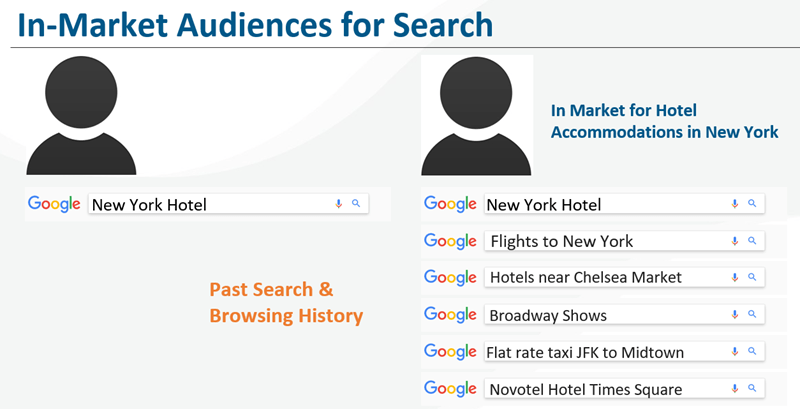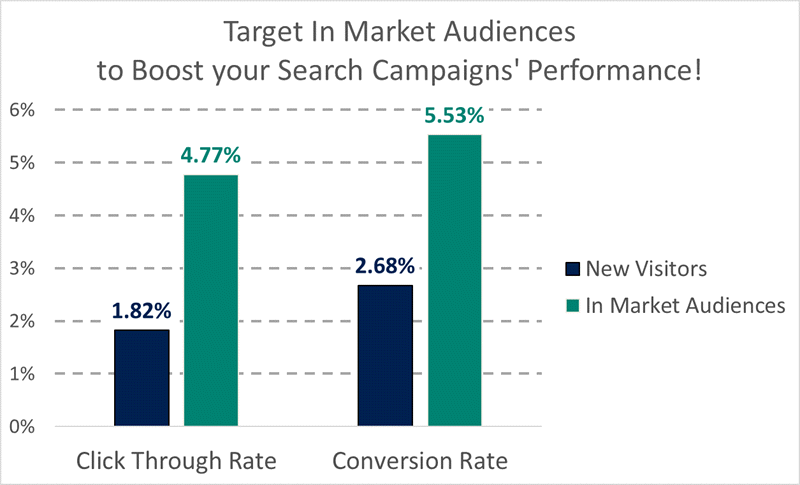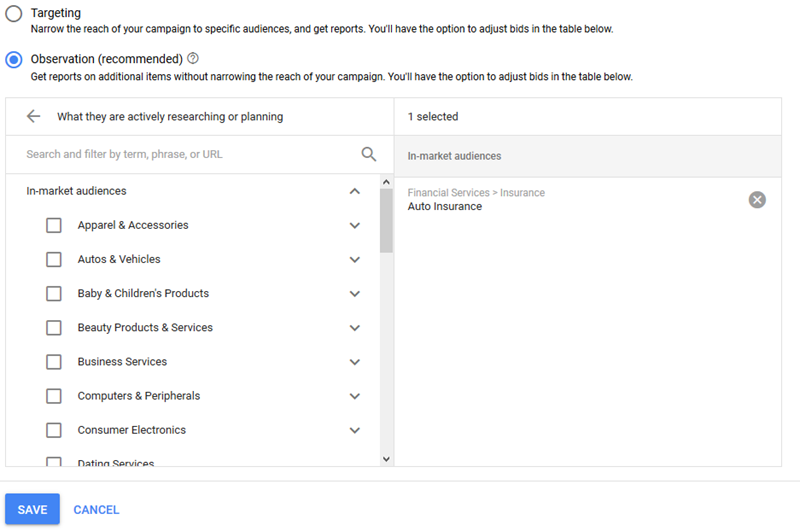Long gone is the world of managing search campaigns with keywords alone! Today, the search marketer has almost as many tools to target their ads with different audience solutions as they do with keywords.
Advertisers can target remarketing audiences within their search campaigns using RLSA, reach their current customers with Customer Match, find new customers using Similar Audiences for Search, or even target specific demographics in their search campaigns.
But today, advertisers have a new tool to reach their audiences on the SERP – In-Market Audiences!
What Are In-Market Audiences for Search?
Google first announced plans to release In-Market Audiences for search campaigns back at Google Marketing Next in May of last year. This month, Google and Bing rolled In-Market Audiences for Search out to all US advertisers.
In-Market Audiences for Search should feel like In-Market targeting for GDN advertisers or Facebook advertisers’ in-market targeting. They allow you to find users whose past search and browsing behaviors indicate that they’re more likely actively searching for your product or service.
Much like RLSA audiences and similar audiences for search, these audiences are generally more qualified than those found on standard search; they’re closer to making a purchasing decision, rather than just beginning to research or consider your brand. But unlike remarketing audiences, In-Market audiences for search may have never heard of your brand or been to your site before, making them the perfect people to introduce yourself to.
In-Market Audiences for Search In Action
Let’s say you’re advertising on the keyword “New York Hotel.”
You’d likely be serving your ad to the tens of thousands of people who search for hotels every day. Thousands of them may just be browsing or beginning to plan their summer vacations but have no intention of booking a room today. But a few have done their research online over the past few weeks, booked their flights, and are ready to book their getaway.
Although their search for “New York Hotels” looks no different from the hordes of less-qualified people on the same keyword, it’s easy for the search engines to see that they’re in-market for accommodations in New York, just based on their past search and browsing history.
This gives you a distinct advantage, allowing you to bid up or reserve your budget exclusively for searches from people who are in “buy-now” mode.
What Will In-Market Audiences for Search Look Like?
The initial release of In-Market Audiences includes over 170 unique In-Market audiences to target from popular industries. There’s opportunity for just about every industry to take advantage of, including Auto, Travel, Legal, Finance, Real Estate, Business services, Education, and more! Both Google and Bing are expected to continuously expand these audiences over time.
Early beta tests targeting In-Market Audiences reveal its strong potential to change your search campaign performance. These carefully curated audiences targeted a smaller share of the people searching for their keywords, but these audiences were 162% more likely to click through on a relevant search ad and more than twice as likely to convert on the same ads!
Further, at no additional cost to reach these audiences, advertisers were able to refine the targeting of their search campaigns and reduce their CPA by more than half on average!
Of course, these In-Market Audiences will have limited reach on the SERP, even for popular industries and keywords.
On average, we’ve seen that only about 5% of searchers are identified as “In-Market” at any given time. Although many advertisers saw up to half of their conversions coming from these highly qualified In-Market Audiences, their limited reach should be carefully considered as you work them into your campaign strategy.
Best Practices for Using In-Market Audiences for Search Campaigns
Try bid-only (or “observe”) targeting first
New features are always exciting and In-Market Audiences will certainly improve your search campaigns, but it’s best to start small at first! Add In-Market audiences to your existing campaigns as a “Bid only” (“Observe” within AdWords) target with a modest bid adjustment to begin.
Over a few weeks, not only will you see your campaigns perform better, but you’ll also collect valuable data to guide your next moves. If you see similar audiences perform well and attract a large audience, then you may want to create a separate campaign targeting these users with a “Target and Bid” (“Target” within AdWords) target. If you’re skeptical or want to be especially cautious, this data comes for free by using a “Bid only” target by applying a +0% bid adjustment.
Test out multiple In-Market Audiences (even the non-obvious ones)
Some targets will naturally make sense for your brand. Sure, a hotel has a lot to gain by targeting someone who’s In-Market for travel. But a savvy luggage retailer could potentially cross-sell their product to these audience looking to get away. Conversely, a B2B service may be smart to exclude or reduce their bids for this audience of searchers whose wanderlust may keep them from converting!
Layer In-Market Audiences with other demographics and audiences
As powerful as In-Market Audiences are, don’t use them as your only signal to determine your qualified searchers. Refine your targeting by reengaging past visitors with RLSA and customer match audiences as well as the demographic targeting options within your search campaigns.
A Step Into the Future
The future of search is not keywords – it’s people.
Using In-Market audiences has the potential revolutionize your search campaigns, help you refine your ads’ targeting, and ultimately save you thousands of dollars in your paid search campaigns!
Data Sources
The aggregated data in this post is based on a sample of 26 WordStream client accounts with early beta access to In-Market Audiences who were advertising on the Bing Search Network in April 2018.






0 Comments